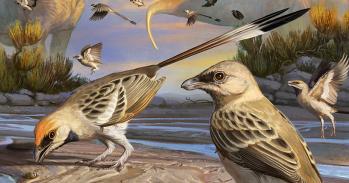
First time ‘wolf in sheep’s clothing’ mimicry has been seen in birds. Host birds have evolved a general counter-strategy in which they defend against all birds with the mimicked plumage - cuckoos and harmless species alike.
First time ‘wolf in sheep’s clothing’ mimicry has been seen in birds. Host birds have evolved a general counter-strategy in which they defend against all birds with the mimicked plumage - cuckoos and harmless species alike.
It's the first time anyone has quantitatively tested for 'wolf in sheep's clothing' mimicry in any adult bird
William Feeney
Brood parasites are reproductive cheats that evolve ways of duping other birds into raising their young. Examples such as mimicry of host eggs, chicks and fledglings by brood parasitic eggs, chicks and fledglings are amongst the most iconic examples of animal deception in nature.
New research shows that adult brood parasitic female cuckoo finches have evolved plumage colours and patterns to mimic a harmless and abundant species, such as southern red bishops, to deceive possible host birds and reduce the risk of being attacked when approaching host nests to lay their eggs.
Researchers say this is the first time that "wolf in sheep's clothing" mimicry has been shown to exist in any adult bird.
While other brood parasites watch the movements of their host victims by hiding in nearby foliage, the openness of the African savannahs mean that mimicking a plentiful and nontoxic species might be the best way cuckoo finches have of sneaking up on host nests without raising the alarm.
However, the researchers found that the most common victim of the cuckoo finch, the tawny-flanked prinia, has evolved an awareness of the cuckoo finch's disguise and takes no chances - acting with equal aggression towards a female cuckoo finch and bishop alike.
Prinias attacked female cuckoo finches and female bishops equally, and increased the rate of egg rejection after seeing either a female cuckoo finch or female bishop near the nest. Egg rejection involves physically removing the parasitic egg from their nest, allowing them to salvage the majority of their reproductive effort.
At the study site in Zambia, the researchers found a consistently high rate of parasitism by cuckoos among the prinia population, with almost a fifth of all prinia eggs hatching as fledgling cuckoo finches. Cuckoo finches usually remove at least one egg on parasitism, and their hatchlings will out-compete all the host's young.
Researchers say these rates of parasitism might explain the willingness of prinias to attack anything that looks like a dangerous female cuckoo finch and reject more eggs when the risk of parasitism is high. But, the cost of this strategy can be high: during the researchers' experiments, some of the eggs rejected by prinia were their own, triggered by nothing more than a harmless bishop bird that resembles the mimetic cuckoo finch.
"Our findings suggest that female cuckoo finches are aggressive mimics of female bishops, and that prinia hosts have responded to this successful deception with generalised defences against cuckoo finches and harmless bishops alike. This suggests these prinias have decided that it's best to 'play it safe' when the risk of parasitism is high because they can't distinguish between the two species" said Dr William Feeney from Cambridge University's Department of Zoology, who led the research.
"While other brood-parasite species monitor host behaviour from concealed perches in nearby trees, cuckoo finches must seek host nests in open grasslands and savannahs. In such exposed circumstances, resembling an abundant and harmless model may allow female cuckoo finches to remain unnoticed when monitoring hosts nests at a medium range," he said.
The research is published today in the journal Proceedings of the Royal Society B.
To investigate the cuckoo finch's disguise, the research team conducted plumage and pattern analysis using cuckoo skins from the Natural History Museum in Tring. They compared plumage to the cuckoo finches closest evolutionary relatives (Vidua finches), as well as with the skins of similar-looking birds (bishops) that share the same habitat.
In both human and bird visual systems, they found that the plumage of a female cuckoo finch is far closer to the bishops and other species in the weaver family than to those of its closest relative, the Vidua finches.
The researchers also investigated the reaction of prinia breeding pairs to models of female cuckoo finches and bishop birds, as well as the males of both species.
While prinias had very little reaction to the males, the female cuckoo finch and the harmless female bishop bird both received similarly high levels of alarm calls and group attacks from the prinia, known as 'mobbing'.
The researchers then did a final experiment where they presented a male bishop, female bishop and female cuckoo finch and then placed a fake egg in their nest. They found that after seeing the harmful female cuckoo finch or harmless (but similar-looking) female bishop, they increased their rate off egg rejection compared to when they saw a male bishop near their nest.
Added Feeney: "This study is interesting as it's the first time anyone has quantitatively tested for 'wolf in sheep's clothing' mimicry in any adult bird, and also suggests that this type of mimicry is used by brood parasites to deceive hosts at all stages of their nesting cycle."

The text in this work is licensed under a Creative Commons Attribution 4.0 International License. For image use please see separate credits above.




